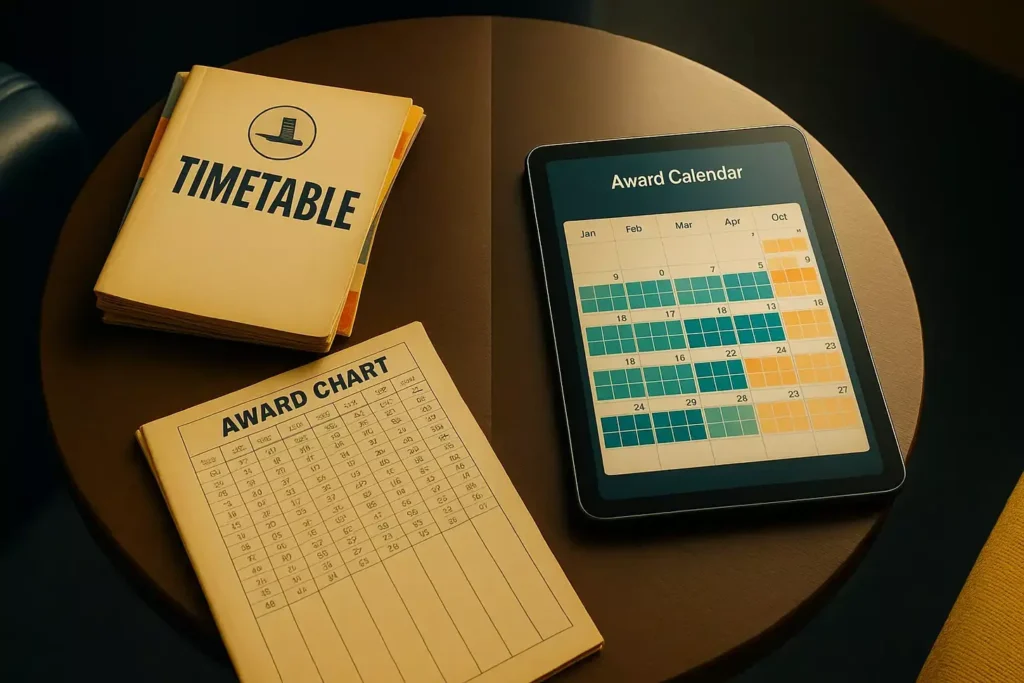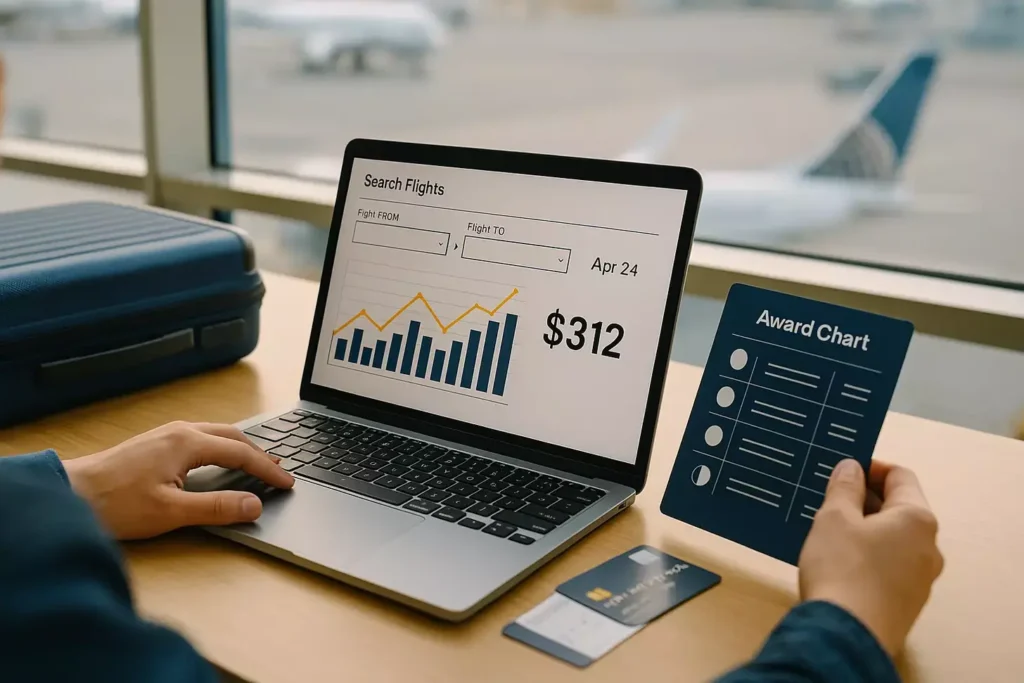Affiliate Disclosure: Award Travel Hub may earn a commission or referral bonus from some links on this site. These affiliate links help support our work and may influence the placement or promotion of certain products or services. However, our content is independently crafted to reflect honest opinions. Not all offers or products are included. There is no additional cost to users when they utilize our affiliate links.
Did you know that over 80% of major airline loyalty programs have abandoned predictable redemption systems in the past five years? This massive shift has fundamentally changed how travelers use their hard-earned miles and points.
We’re here to guide you through this evolving landscape. The core difference lies between two distinct approaches: market-responsive cost structures and traditional fixed-rate systems. One adapts to demand, while the other offers consistency.
Major carriers like United, American, and Delta have fully embraced fluid cost models. This means redemption rates can fluctuate based on seasonality, route popularity, and booking timing. Meanwhile, some programs maintain set redemption tables that provide predictable value.
This guide will help you understand which carriers maintain traditional systems. We’ll show you how to identify the best programs for your travel style. Our goal is to help you maximize every point you earn.
Understanding these models is crucial for strategic planning. It affects your ability to find great deals and plan dream vacations. We provide transparent, data-driven insights to help you make informed choices.
Key Takeaways
- Most major airlines have moved away from predictable redemption systems
- Two main pricing models exist: market-responsive and fixed-rate systems
- Market-responsive models change costs based on demand and timing
- Fixed-rate systems offer consistent redemption values
- Your choice of loyalty program should align with your travel planning style
- Understanding these models helps maximize your points’ value
- Strategic planning requires knowing which programs offer predictability
Introduction to Airline Pricing Models
Before you can book your dream trip with points, you need to understand the fundamental difference in how airlines price their award seats. This knowledge is key to maximizing your loyalty program’s value when airlines price their award seats. This knowledge is the key to maximizing your loyalty program’s value.

We’ll break down the two main systems you’ll encounter. Understanding them will transform how you plan your travel.
Overview of Dynamic Pricing and Award Charts
One model, often called dynamic pricing, links the cost per mile directly to the ticket’s cash price. When demand is high and dollar fares rise, the mileage cost for the same seat also increases.
The other system relies on published award charts. These charts set fixed redemption rates. The cost is based on factors such as travel distance, region, and season, not the current cash fare.
This creates predictability. You know precisely how many miles you need for a flight, regardless of price swings.
Benefits for Frequent Flyers
Fixed award charts offer planners a significant advantage. They eliminate guesswork, allowing you to budget your miles well in advance for trips.
This structure also helps savvy travelers find “sweet spots.” These are routes where the fixed mileage cost provides exceptional value compared to the ticket’s retail price.
Some carriers now use hybrid models. They show baseline prices while allowing flexibility. Knowing the core models helps you navigate any program effectively.
The Evolution of Airline Award Charts
The journey of airline loyalty programs began decades ago with a revolutionary idea from American Airlines. Their pioneering frequent flyer program in the 1980s laid the foundation for the miles-based travel rewards we know today.
Traditional Fixed Pricing Models
Originally, airline programs used predictable award charts that provided clear redemption rates. Travelers could know precisely how many miles they needed for specific routes and cabins.
This transparency enabled strategic long-term planning. The fixed structure created well-known “sweet spots” where savvy travelers could extract exceptional value.
Sometimes, Premium Cabin flights costing thousands of dollars in cash were available for a fraction of that cost in miles. This made loyalty programs incredibly powerful for strategic travelers.

The Shift Towards Dynamic Pricing
Delta SkyMiles became the industry pioneer by abandoning fixed award charts. This move set off a domino effect, prompting many major carriers to follow suit.
The shift is driven by advanced technology and revenue management objectives. Airlines now align award costs with each seat’s actual cash value.
This approach helps maximize revenue while influencing customer behavior. It also eliminates the predictable sweet spots that reduced profitability under traditional models.
Dynamic Pricing vs. Award Charts: Which Airlines Still Offer Fixed Rates?
The search for predictable point redemption leads many travelers to seek out carriers with set mileage tables. While most major programs have shifted to market-responsive models, several notable exceptions maintain traditional structures.
Examples from Major Airlines
Alaska Airlines stands out with its distance-based Mileage Plan. Flights within the continental U.S. start at just 5,000 miles for trips under 700 miles.
ANA Mileage Club offers exceptional value through its fixed-distance structure. This system provides consistent costs for Star Alliance partner flights regardless of demand fluctuations.
British Airways uses a purely distance-based Avios model. This approach delivers great value on short-haul routes but can become costly for longer journeys.
| Program Type | Airlines | Key Features |
|---|---|---|
| Fixed Award Charts | Alaska Airlines, ANA, British Airways, Cathay Pacific, Frontier | Predictable mileage costs, distance-based pricing, consistent sweet spots |
| Hybrid Models | Air Canada Aeroplan | Fixed rates on select partners, dynamic pricing on mainline flights |
| Fully Dynamic | United, Delta, American, Southwest, JetBlue | Costs fluctuate with cash fares; no published charts |
Air Canada Aeroplan employs a hybrid approach, with fixed costs applied to certain partner carriers. Frontier Miles maintains a straightforward chart with U.S. flights starting at 5,000 miles.
These programs provide the consistency that helps travelers plan effectively. They eliminate guesswork when budgeting for future trips.
Understanding Dynamic Pricing: How It Works
Have you ever searched for the same flight on different days and found wildly different mileage costs? This fluctuation is the heart of dynamic pricing systems that many carriers now employ.
We’ll demystify how these systems actually function. Award costs change in near real-time based on cash ticket prices, demand levels, and market factors.
Real-Time Fare Adjustments
Sophisticated airline revenue management systems continuously analyze booking patterns. They adjust award pricing to optimize revenue.
The same business class seat might cost 50,000 miles during low-demand periods. During peak holiday travel, it could balloon to 200,000 miles or more.
Impact of Demand and Revenue Management
The strategic rationale behind this model is clear. Airlines protect high-value inventory by pricing awards high during peak periods.
They stimulate demand on less popular routes by lowering costs. This prevents “losing” revenue on valuable premium cabin seats.
While dynamic pricing can offer good value during off-peak times, it generally eliminates the predictability that made traditional systems valuable.
Demystifying Fixed Award Charts and Their Benefits
The true power of fixed award charts lies in their ability to remove uncertainty from travel planning. These published tables give you concrete numbers for your redemptions, creating a stable foundation for strategic mileage use.
We find that this predictability transforms how travelers approach their goals. You can confidently save for specific trips knowing the mileage cost won’t suddenly increase.
Predictability and Sweet Spot Redemptions
Fixed charts eliminate the guesswork that comes with fluctuating systems. You always know whether you have enough miles for your desired flight.
This structure creates valuable “sweet spots.” These are routes that offer exceptional value for your points. You might book a premium cabin seat that costs thousands in cash for a modest number of miles.
For zone-based charts, maximize value by pairing the longest routes within each zone. A flight from Los Angeles to Warsaw might cost the same number of miles as a flight from New York to London.
Distance-based charts often offer great deals on short-haul flights. Regional trips can provide disproportionate value compared to their cash prices.
While these charts don’t correlate with cash fare sales, they also protect you from peak season inflation. This consistency makes them invaluable for advanced planners seeking reliable redemption opportunities.
Case Studies: Airline Programs and Award Strategies
The best way to grasp the real differences between airline loyalty models is through hands-on case studies of actual programs. We’ll examine how different approaches translate into real value for your travel.
Insights from Air Canada Aeroplan and Alaska Airlines Atmos
Air Canada Aeroplan employs a hybrid model that offers stability on select partners. Their published chart lists fixed costs for carriers such as Emirates and Etihad.
Meanwhile, Air Canada itself uses “starting from” pricing. This creates flexibility while maintaining some predictability.
Alaska Airlines bases award flight costs on route popularity and distance. This creates exceptional sweet spots for savvy travelers.
Economy seats to Asia on Cathay Pacific cost just 30,000 miles. Flights to Australia on American Airlines are only 40,000 points. These represent outstanding value during peak seasons.
Delta SkyMiles and the Pioneer of Dynamic Models
Delta SkyMiles pioneered the shift to market-responsive systems. Their approach consistently yields about 1.1 cents per mile across all cabins.
A Newark to Detroit round-trip costing $379-$639 translates to 33,000-58,000 miles. This model extends to their extensive partner network, including Air France and Virgin Atlantic.
Even when booking partner awards, you can’t escape fixed charts. This demonstrates the comprehensive nature of their system.
Strategies to Maximize Your Loyalty Program Value
Transforming your loyalty program membership into luxury travel experiences hinges on smart redemption strategies. We’ll show you how to extract maximum value regardless of your program’s pricing model.
Tips for Finding Award Flight Sweet Spots
Exceptional redemption opportunities exist in every system. Focus on long-haul flights within favorable zone pairings for maximum mileage efficiency.
Booking partner awards can unlock hidden gems where traditional charts still apply—target off-peak travel periods when availability increases dramatically.
“The savvy traveler compares multiple programs for the same route—one program’s sweet spot might be another’s expensive redemption.”
Distance-based charts offer incredible value on short regional flights. Always compare transferable points currencies to optimize your booking options.
Leveraging AwardFares and Other Tools
Powerful search platforms revolutionize how you find award seats. AwardFares scans availability across 14 frequent flyer programs and 50+ airlines.
| Tool Feature | Benefit | Best For |
|---|---|---|
| Real-time alerts | Instant award space notifications | Last-minute opportunities |
| Historical data | Pattern recognition | Strategic planning |
| Seat maps | Cabin selection | Premium class redemptions |
Set up alerts for your desired routes and maintain flexible dates. Comparing programs side-by-side ensures you always get the best redemption rate.
These strategies transform theoretical knowledge into practical action. You’ll consistently maximize the value of your hard-earned points and miles.
Conclusion
Your ability to maximize travel rewards ultimately depends on selecting the right program model for your planning style. We’ve shown how market-responsive systems differ from traditional published tables, with each offering distinct advantages.
Carriers like Alaska Airlines and ANA maintain predictable structures, while major U.S. programs use fluid cost approaches. The industry trend clearly favors revenue-driven models, but strategic travelers can still find exceptional value.
Using tools like AwardFares helps navigate this complex landscape. Comparing multiple programs and setting alerts ensures you secure the best redemptions.
Stay informed about program changes as carriers continue evolving their approaches. We’re committed to providing transparent guidance that helps you make confident decisions about your loyalty strategy.



